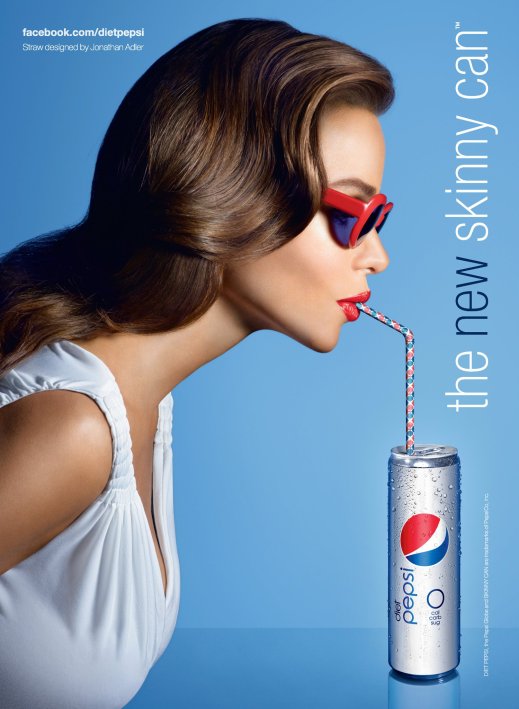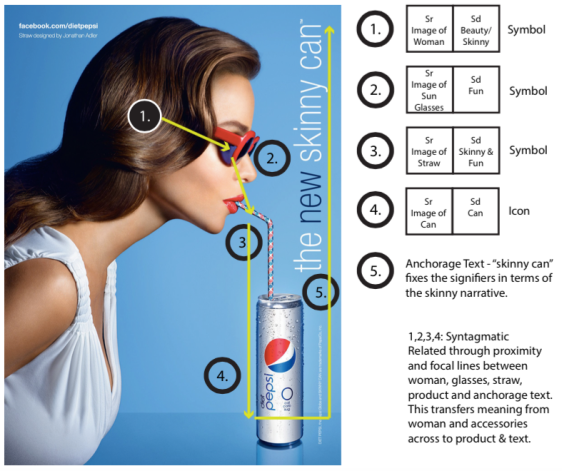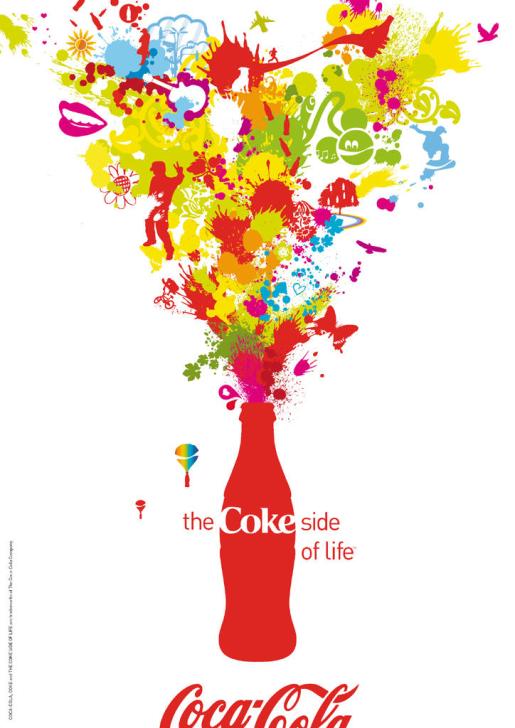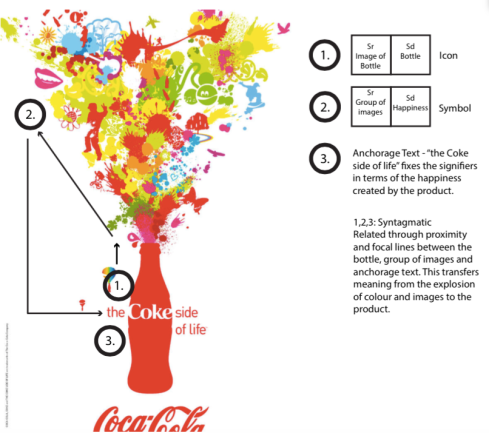Michaela Connors // n859 6603
Date of Post: 16/08/2015
Semiotics Analysis
Semiology is the study of signs and directs the analysis and focus on the different meanings behind symbols within an image (Rose, 2001). This allows the viewer to deconstruct an image into building blocks, that allows us to understand how it works in relation to its greater meaning.
Pepsico // Diet Pepsi // 2011 // Poster // Size Varies
Advertising Campaign // United States of America // General Viewing
Source: http://wanphing.com/2011/05/28/diet-pepsi-skinny-can/
Figure 1.1. Annotated Pepsi Advertisement
The primary signifier (Sr) is a woman (Sofia Vegara). What is signified (Sd) by the woman is the conventional notion of female beauty and ‘skinny’. The subsequent signifiers including the sunglasses and straw, work together with the woman to convince viewers that the new Diet Pepsi is fun and will make you ‘skinny’. Pepsi depends on the audience knowing that Vegara is skinny, beautiful and fun; she has been encoded to transfer the signified from her, to the product (Rose, 2001). This is therefore a connotive sign, with a higher level meaning, as Vegara is included to not only represent a beautiful woman, but also the Pepsi drink.
The symbolic relationship of Vegara, or other similar female celebrities symbolising timeless beauty, is conventionalised primarily in Western culture. The text on the advertisement stands as anchorage, as it focuses, directs and leads the ‘skinny’ narrative being told (Rose, 2001). The signifiers in the advertisement are syntagmatic, as when combined, they work together in close proximity to derive meaning. This is supported by the red, blue and silver hues that emphasise the branding and tie all elements together.
Coca Cola // Coke Side Of Life // 2006 // Size Varies
Poster // Advertising Campaign // Global // General Viewing
Source: Coca Cola, http://www.coca-colacompany.com/press-center/image-library/2006-coke-side-of-life
Figure 1.2. Annotated Coca Cola Advertisement
The signifier in the Coca Cola advertisement is the image of the coke bottle. What is signified is the product. According to Atkin (2013), this is an icon as it represents the signifier through a direct likeliness. This sign works with the explosion of colour and small illustrations, an additional signifier. This graphic is signified by the audiences happiness, joy and adventure. Depending on the individual and different cultural constructions, the viewers will have different interpretations based on what happiness means to them. The highly saturated colours and meaning of the smaller components (bird = freedom, smiles = laughter, heart = love) create a symbolic relationship of happiness. As the graphic and each of its elements have a higher level meaning, it is a connotive sign (Rose, 2001).
The text in the advertisement acts as anchorage by narrowing the meaning and leading the audience to understand the ‘happiness in a bottle’ that is signified. The advertisement presents a syntagmatic sign, as the viewer must combine the Coca Cola bottle, with the explosion of colour and the text to understand the ‘happiness in a bottle’ meaning (Rose, 2001).
Critique
After much deliberation over the symbols in the Pepsi ad, firstly considering each of the building blocks lead to the discovery of a clear syntagmetic flow. Pepsi has consciously chosen symbols that work together to derive a greater meaning. In contrast; a weakness of the global Coca Cola ad, is the unconsidered elements that may not present a symbolic meaning of ‘happiness’ across cultures.
The semiotics analysis was evidently one of the hardest tools to comprehend and apply to images. However, the angst over a particular symbols meaning, demonstrated how signs can suggest more than one thing to a viewer. Therefore, designers must consider the culture and context of where images may be viewed, to understand how the viewer will derive meaning.
References
Atkin, A. (2013). Peirce’s Theory of Signs. The Stanford Encyclopedia of Philosophy, Edward N. Zalta (ed.), Retrieved from http://plato.stanford.edu/archives/sum2013/entries/peirce-semiotics/
Rose, G. (2001). Visual Methodologies : An Introduction to the Interpretation of Visual Materials. London, GBR: SAGE Publications Inc. (US). Retrieved from http://www.ebrary.com




